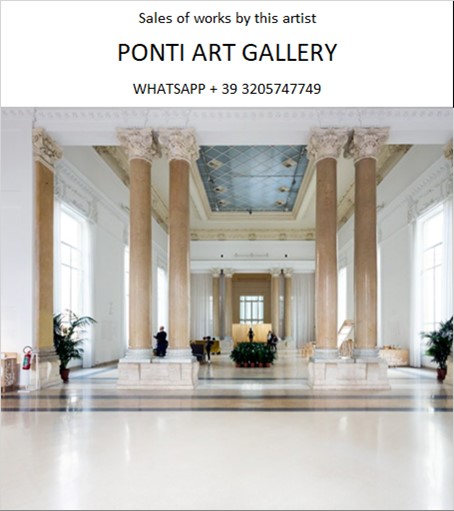Ponti Art Gallery is interested in buying and selling works
of art by this artist.

Gu Dexin Biography
Gu Dexin, born in 1962 in Beijing, China, is a seminal figure in the realm of contemporary Chinese art, renowned for his avant-garde installations that delve into themes of decay and permanence. His artistic journey began in the late 1970s, a period marked by the end of the Cultural Revolution and the emergence of a more open political and social atmosphere in China. This era saw the formation of various art collectives and societies in Beijing and Shanghai, among which Gu Dexin was a founding member of the New Measurement Group, alongside Wang Luyan and Chen Shaoping.
Gu Dexin's early artistic endeavors were characterized by experimentation with established styles, including expressionistic painting and plein-air landscapes. However, around the age of 20, his work took a radical turn as he began to depict dystopian realms filled with sexually-charged creatures through his paintings, watercolors, and embroideries. His sculptures, crafted from blowtorched plastic, resembled human innards, and he also dabbled in simple computer animations.
Gu Dexin's subversive approach extended to his installations, which often featured perishable goods such as fruits, meat, and animal intestines left to rot in exhibition spaces. These works were a direct commentary on the dichotomy of decay and permanence, challenging viewers to confront the impermanence of life and the inevitability of decay. His critical stance towards the commercialization of politics in art was evident in his installations, which sometimes filled museum lawns and hallways with decomposing fruit.
In 1989, a pivotal year in Chinese history, Gu Dexin's work gained international attention when his blowtorched plastics were showcased in the China/Avant-Garde exhibition at the National Art Museum of China in Beijing. This exhibition is widely recognized as a significant moment in the global presentation of contemporary Chinese art. Six years later, Gu Dexin's work was featured in the Venice Biennale satellite exhibition Asiana: Contemporary Art from the Far East, where he transformed a Venetian palazzo into a sanguine morgue with decaying chunks of beef in transparent coffins.
Gu Dexin's resistance to interpretation and his reclusive nature earned him the moniker of a 'monastic Bartleby' by academic and curator Philip Tinari. Despite his withdrawal from the art world in 2009, Gu Dexin's legacy remains impactful. His final solo show, 2009-05-02, held at Galleria Continua in Beijing, was a testament to his provocative style, featuring white-washed panels with repeating phrases of violent and cannibalistic actions, juxtaposed with televisions screening footage of blue skies.
In 2012, the Ullens Center for Contemporary Art (UCCA) in Beijing hosted a major retrospective titled Gu Dexin: The Important Thing Is Not The Meat. Curated by Tinari, the exhibition showcased nearly 300 largely unseen works, revealing the depth and complexity of Gu Dexin's practice beyond his notorious flesh-related installations. The retrospective included a diverse range of media, from model cars, paint, and plasticine to animation, SimCity, and sculpture.
Gu Dexin's work has been exhibited in numerous galleries and museums across China and internationally, including France, Spain, Switzerland, Italy, Belgium, the USA, and the UK. His decision to end his career and return to a "normal" life in the same Beijing residential compound where he grew up and created his art has been interpreted by many as a profound statement, not as a rejection of art but as a protest against society.
Gu Dexin's artistic output is marked by a constant evolution, from surrealistic, figurative paintings to animation and a quieter mode of installation. His insistence on not imposing meaning onto his works, often titling them with serial numbers or simply the date of completion, reflects his desire for the viewer to engage with the work without preconceived notions. The recurring elements of apples and sides of meat in his oeuvre, first depicted in paintings and later as real objects in installations, underscore the thematic continuity and the provocative nature of his art.
Despite his departure from the art scene, Gu Dexin's influence persists, and his work continues to be a subject of study and admiration. His unique approach to materiality, his exploration of societal taboos, and his critical perspective on the political and social landscape of contemporary China have cemented his status as a pivotal figure in the history of Chinese contemporary art.
Gu Dexin Quotes and Sales of
Works
Ponti Art Gallery selects and deals with paintings by the
artist. Upon request, we provide free estimates and
evaluations, communicate prices, quotations, and current
market values.
If you are interested in BUYING or SELLING works by the
artist, contact us immediately.
If you wish to sell or receive an evaluation of the
works:
Send us a frontal photo of the painting, one of the back,
and one of the signature. Also, indicate the dimensions of
the work. Inform us about the purchase origin of the work
and any kind of available documentation (purchase
receipts, certificates of authenticity, publications). One
of our operators will respond to you on the same day. We
guarantee maximum confidentiality and extreme
professionalism.
If you wish to purchase works by the painter: Contact us
and let us know your request. We will inform you about the
available works. We also offer the possibility to
subscribe to our NEWSLETTER, through which you will be
informed at the beginning of each month about the latest
acquisitions of the art gallery.
You can send us pictures of the work:
